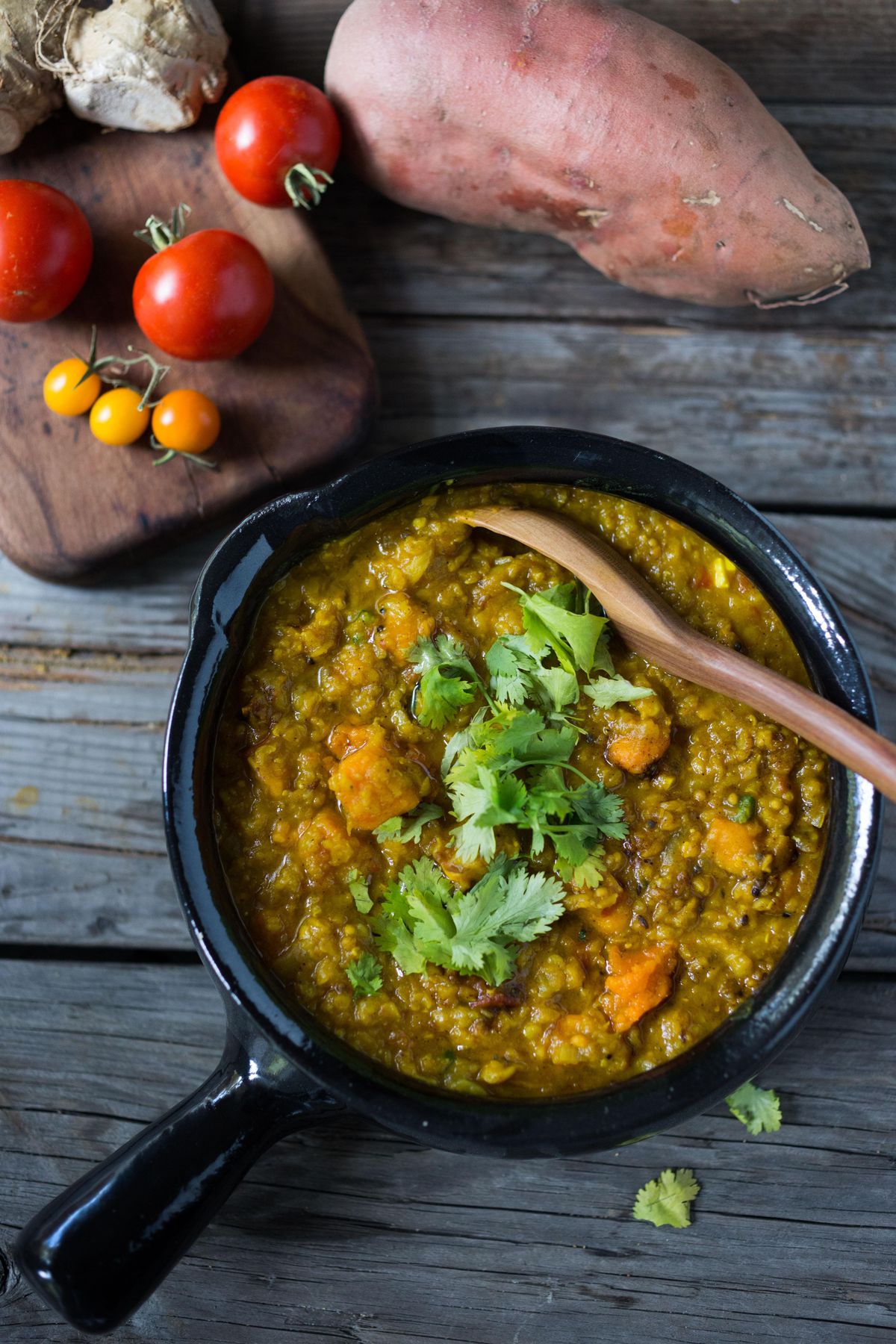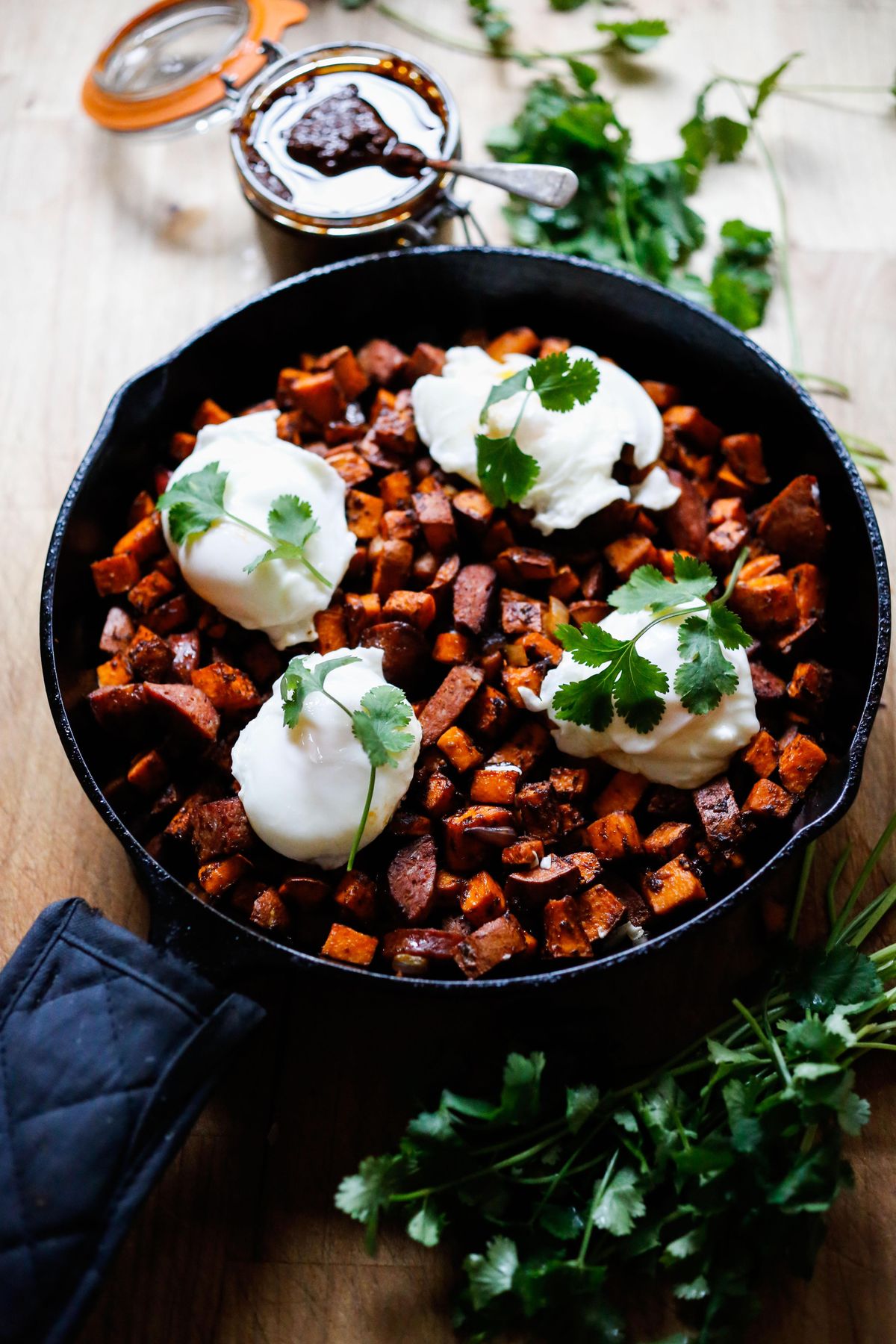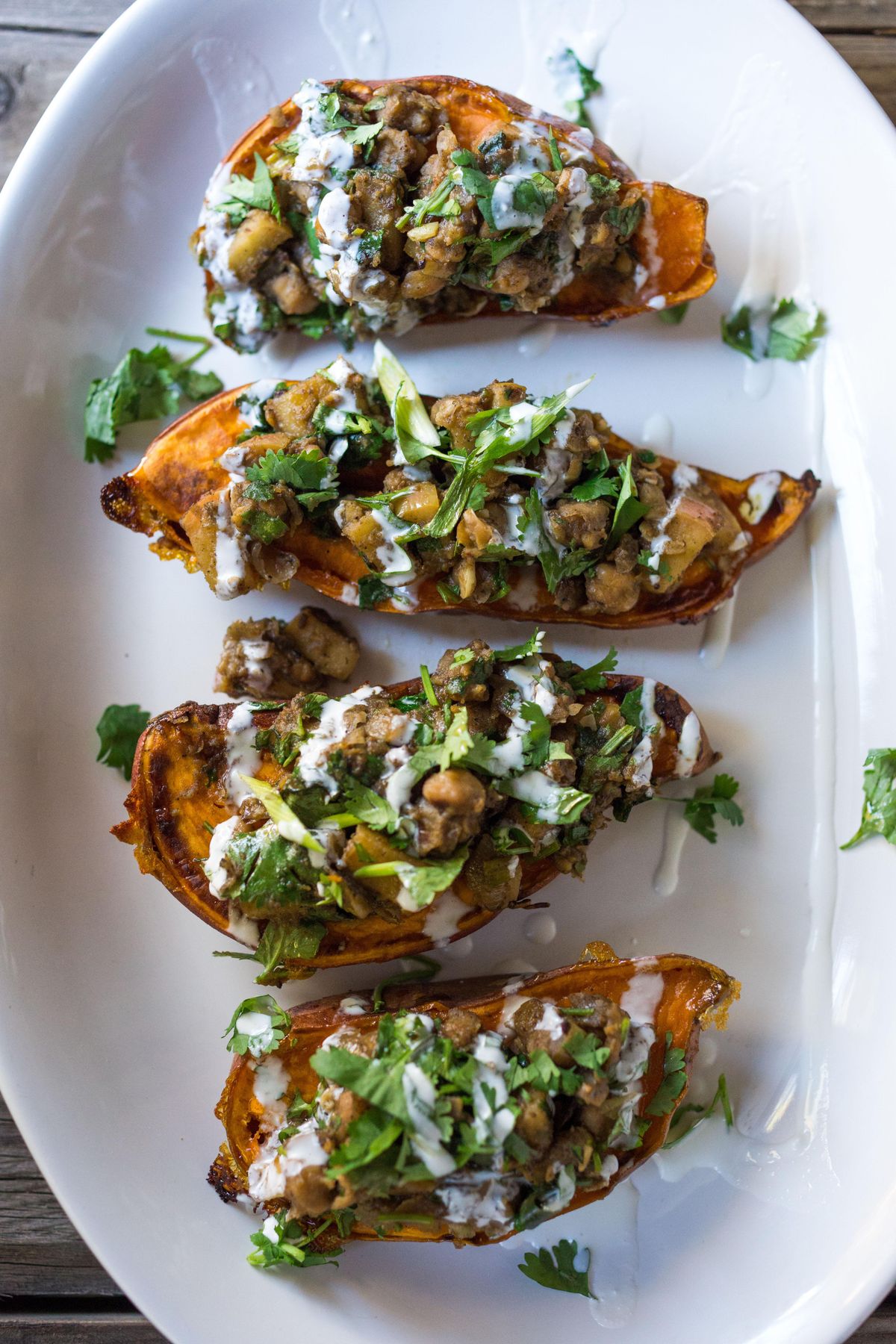Sweet potatoes offer taste of fall
Moroccan Stuffed Sweet Potatoes with Ras El Hanout. (Sylvia Fountaine / Sylvia Fountaine Special to Food)
As summer shifts into fall, appetites move into high gear. Perhaps it’s the cooler weather, the darkening days or the deep primal instinct to eat as much as possible before the scarcity of winter arrives.
One of my go-to healthy comfort foods is sweet potatoes. These nutritional powerhouses are not only loaded with vitamins A and C, potassium and phytochemicals like lutein and zeaxanthin, they are full of fiber and surprisingly low in calories.
Naturally filling, they can easily be prepared quite healthfully – without the addition of too much fat, sugar or richness. Perhaps those add-ons are what’s given them a bit of a bad rap, especially around Thanksgiving when they’re served smothered in butter and marshmallows. Maybe it’s time we think of them differently.
People often get confused between yams and sweet potatoes. What we often see labeled as yams in most grocery stores is actually a different type of sweet potato with a rich orange flesh and a reddish-brown exterior. They have been labeled yams to differentiate them from their paler, drier relative.
True yams are rarely found at conventional grocery stores, showing up sporadically at local ethnic markets, most recognizable by their black and rough, bark-like skin.
And to further clarify, sweet potatoes aren’t actually potatoes. They are in the Convolvulaceae family with flowering morning glory vines. Unlike potatoes, you can also eat the the heart-shaped leaves of sweet potatoes, which are very nutritious.
Originating from Central and South America, sweet potatoes are thought to have been domesticated 5,000 years ago and introduced to Europe by Spanish explorers. Ancient relatives of sweet potatoes, dating back to 8000 B.C., have been found in Peru.
There are many varieties of sweet potatoes, but for the sake of simplicity, they can be divided into two groups: the pale, dry-fleshed, nutty flavored types and the dark, moist-fleshed and sweeter varieties.
In addition to variations in color, sweetness and flavor, sweet potatoes types are quite different in texture. The pale varieties are drier and will whip up better into purees and mashes, while orange varieties hold together better after cooking – so great for adding to soups and stews.
The simplest way to cook a sweet potato is to to either slice it in half lengthwise or roast it whole with the skin on, in a 400-degree oven until tender, about 30 to 40 minutes. Slice it open and sprinkle with salt, pepper and a drizzle of maple syrup. Try leaving the butter off, and enjoy its inherent richness.
To turn a whole roasted sweet potato into a main dish, stuff it like you would an enchilada with shredded chicken and chilies – or keep it lean and vegetarian, with black beans and corn, using your favorite taco seasoning. Stuff the yams, placing them back in the oven, like you would with twice-baked potatoes.
Sweet potatoes are also a healthy and filling alternative for breakfast. Orange sweet potatoes blend up naturally into silky smooth soups. And, they’re perfect additions to Indian dishes like curries or dal.
Moroccan Stuffed Sweet Potatoes with Ras El Hanout
In this healthy recipe for Moroccan Stuffed Sweet Potatoes, chickpeas and apples are sauteed with onion and garlic, then seasoned. The roasted orange sweet potatoes are stuffed with the chickpea apple mixture, placed back in the oven for few minutes, then sprinkled with fresh cilantro, scallions and “smoked” yogurt. The Moroccan spices pair deliciously with the sweetness of the sweet potato.
For the stuffed sweet potatoes
2 to 3 medium orange sweet potatoes, cut in half lengthwise, skin on
1 tablespoon olive oil
1/2 an onion, diced
1/2 an apple, diced
4 garlic cloves, rough chopped
1 can chickpeas, drained and rinsed
2 teaspoons ras el hanout spice blend
1/2 teaspoon salt
1/4 teaspoon pepper
2 teaspoons maple syrup
1/2 cup chopped cilantro, divided
1/4 cup chopped scallions
For the “smoked” yogurt drizzle
1/4 cup plain yogurt
1/8 cup water
1/4 teaspoon smoked salt (or use regular salt plus 1/4 teaspoon smoked paprika)
Preheat oven to 400 degrees. Place sweet potatoes, cut-side down, on a parchment-lined baking sheet and roast for 30 to 40 minutes until tender.
While sweet potatoes are roasting, make filling. Saute onion and apple in olive oil, in a large skillet, over medium high heat for 2 to 3 minutes. turn heat to medium. Add garlic. Saute 4 more minutes, then add chickpeas and spice, salt and pepper. Continue cooking a few more minutes. Stir in maple syrup. At this point, it may seem a little spicy, but when stuffed into the sweet potato, flavors will mellow. Stir in half of the cilantro. Turn heat off.
When sweet potatoes are done, flip and slit the middle gently with a knife and divide the filling, mounding up on the sweet potatoes. Place back in the oven until ready to serve. Garnish with fresh cilantro and scallions and a drizzle of “smoked” yogurt.
Thai Sweet Potato Soup with Lemongrass
In this flavorful recipe, coconut milk is added sparingly to keep it light, lean and low in calories. Ginger, chilies and just the right balance of sweet, salty, tart and umami flavors makes this one of my personal favorites. To add crunch, without adding the fat and calories of croutons, try popping tiny sorghum grains, like you would popcorn, and sprinkle over the soup for a satisfying contrast in textures.
2 shallots (or 1/2 an onion), diced
2 tablespoons coconut oil (or olive oil)
6 cloves garlic, chopped
1/2 cup finely chopped lemongrass (packed)
1/4 cup chopped ginger
1 small Serrano chili (or jalapeno for less spicy), diced
1 teaspoon yellow curry powder
1/2 teaspoon turmeric
7 cups chicken or veggie stock
2 pounds sweet potatoes, peeled, cubed
1 large carrot (for color- this is optional), peeled, sliced
1/2 cup to 1 can coconut milk
2 teaspoons brown sugar
2 to 4 teaspoons soy sauce, to taste
2 tablespoons lime juice
Salt and pepper to taste
Cilantro, coconut milk, scallions, popped sorghum grains, sriracha sauce and lime wedges, for garnish (optional)
In a large, heavy-bottomed pot, heat coconut oil over medium high heat. Add shallot and stir, cooking for 2 minutes. Add ginger, garlic, lemongrass and chili, turn heat to medium and cook for 3 to 5 minutes, until fragrant and golden. Add spices and stir for 1 to 2 more minutes. Add stock.
Bring to a boil and add sweet potatoes and carrot, if using. Simmer uncovered until yams are fork tender, 15-20 minutes. Let cool a bit, while you prepare your garnishes.
Puree soup until very smooth. Either blend in small batches in a blender or use a submersion blender. Get this as silky smooth as you can. Return to the stove and heat on medium low.
Stir in ½ cup of coconut milk – or, if unconcerned with fat content, or want a richer soup, add more, or most of the can, reserving some of the harder “cream,” for the garnish.
Add the brown sugar, 2 teaspoons soy sauce and the lime juice. Taste. Depending on how rich and flavorful your stock is, or how much coconut milk you’ve added, you will need to adjust the seasonings. You may need to add more depth (soy sauce) or a pinch or two of salt, or more lime, or more sugar, or more heat.
There is a balance to find here between salt, sweet and sour and spicy. Find it. This is where you develop your own palate, which no recipe can teach. It just takes practice. Play, add, taste. Add again. Taste.
A little sriracha sauce can work miracles because it contains salt, acid, sweet along with heat and spice. But use sparingly for best results.
Garnish with cilantro, scallions, coconut milk (whisk with a little warm water to loosen) and popped sorghum (optional) and serve with lime wedges.
Harissa Sweet Potato Hash with Poached Eggs
Instead of making fried potatoes with your eggs, try this baked sweet potato “hash” seasoned with flavorful harissa paste and topped with eggs.
2 medium orange or pale sweet potatoes (or 6 cups 1/2-inch diced), skins on
3 to 5 tablespoons harissa paste (see recipe below, or use store bought)
Salt and pepper, to taste
4 to 6 eggs
2 to 3 Merguez sausages (or substitute chorizo, or soy chorizo)
1/2 onion, diced
Cilantro leaves
Preheat oven to 400 degrees. Scrub and dice sweet potatoes, into uniform ½-inch cubes, leaving skins on.
In a large bowl, toss with a few tablespoons harissa paste. (Each harissa is different, so taste as you add. This version is mild so I add quite a bit, about 5 to 6 tablespoons. Yours may be more spicy. If so, dilute with olive oil.) Make sure sweet potatoes are coated well. Season with salt and pepper to taste.
Place on a parchment-lined baking sheet, making sure they are not too crowded. This will allow them to crisp, rather than steam. Stir after 15 minutes. Check again after 10 minutes. Roast until crisp and tender.
While roasting, brown Merguez sausage (or chorizo, or soy chorizo) with the onions in a skillet, over medium heat with a little oil.
Poach or fry eggs, season with salt and pepper and set aside.
Remove the sweet potato hash from the oven, and fold into the skillet along with the sausage and onions, and stir to combine. Gently place eggs over top, garnishing with fresh cilantro and, if you like, more harissa paste. Serve immediately.
Harissa Paste
4 ounces assorted dried chilies
6 to 8 garlic cloves
1 tablespoon cumin seeds
2 teaspoons caraway seeds
1 tablespoon coriander seeds
3 tablespoons olive oil
1 3/4 teaspoon kosher salt
1 tablespoon fresh lemon juice
1 teaspoon smoked paprika
Bring chilies to a boil in a large pot of water, turn heat off, cover, let sit 1 hour or overnight. Toast spices and grind them.
When chilies are rehydrated, remove seeds and stems. Place all the ingredients in a food processor and pulse until desired consistency.
To store, place in sealable jar and drizzle olive oil over top after each use, to preserve. It will last 1-2 months in the fridge.
Makes: 1 ½ cups
Sweet Potato Lentil Dal
The tempering oil gives the dal a burst of flavor with its toasted whole spices. Served with toasty naan bread or over basmati rice, it is perfect for a weeknight meal, coming together quickly and easily
For the lentils
1 cup red split lentils
1 tablespoon coconut or vegetable oil
1 onion, diced
1 tablespoon fresh ginger, grated or minced
4 cloves garlic, minced
2 teaspoons cumin ground
2 teaspoons turmeric powder
2 teaspoons coriander
1 teaspoon paprika
1/2 to 1 Serrano chili, (or 1 jalapeno) finely chopped
1 medium pale or orange sweet potato, diced into 3/4-inch cubes, skins OK
3 cups water or vegetable stock
2 medium tomatoes, diced (or one can diced)
Handful fresh chopped cilantro leaves or chopped scallions
Flaked coconut (optional)
4 cups cooked rice (optional)
4 slices toasted naan bread (optional)
For the spiced tempering oil (optional)
1 teaspoon cumin seeds
1 teaspoon fennel seeds
1 teaspoon mustard seeds (black mustard, if possible)
2 smashed cardamom pods
1 teaspoon turmeric powder
1 teaspoon paprika
2 to 3 tablespoons ghee, coconut oil or vegetable oil
Rinse lentils and soak in a bowl of water. In a large, heavy-bottom pot or Dutch oven, heat oil over medium high heat.
Sauté onion for 2 minutes, stirring, then add ginger. Sauté 2 more minutes, then add garlic and turn heat to medium. Add spices. Stir for another minute letting spices toast, then add sweet potatoes. Strain lentils and add to the pot, along with water and tomatoes. Give a stir, bring to boil, cover, and turn heat down, and let gently simmer, covered, for 20 minutes or until lentils are tender.
Make the flavorful tempering oil. Place seeds in one small bowl and ground spices in another so they are ready to go and close to the stove.
In a small skillet, melt ghee over medium high heat. When skillet is hot, add seeds, swirling and stirring, for 30 seconds, then add spices, stirring for 30 seconds. When seeds pop, cover with a lid. Turn heat off. Let sit until lentils are done.
Check lentils after 20 minutes. If they are done, but it’s too watery, let simmer uncovered until it’s to your desired consistency. Or add more water if necessary. Swirl in tempering oil, divide into bowls over rice or with toasted naan bread. Top with fresh cilantro, scallions or flaked coconut.
The Seasonal Kitchen is a monthly feature. Local chef Sylvia Fountaine writes about seasonal foods she’s making in her kitchen, sharing recipes and a passion for local foods. Fountaine is a caterer and former co-owner of Mizuna restaurant. She writes about home cooking on her blog, Feasting at Home, www.feastingathome.com.


